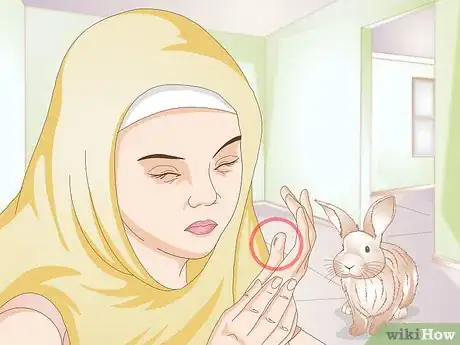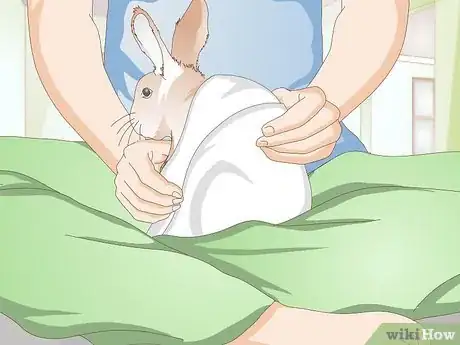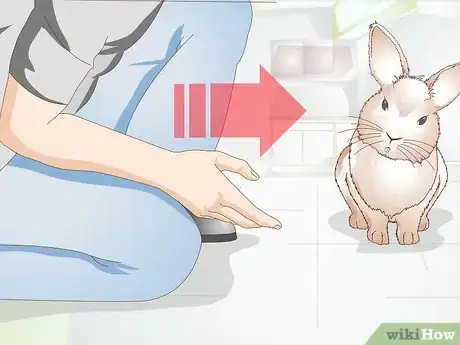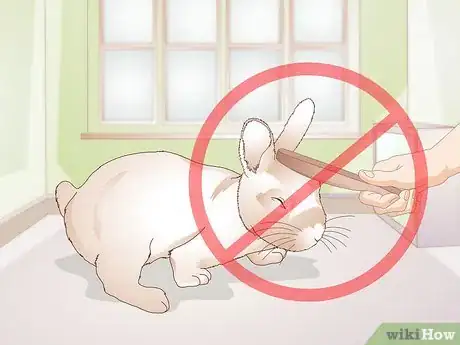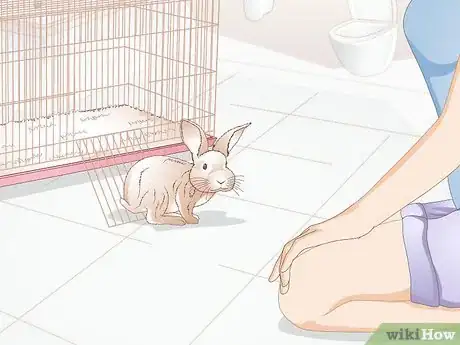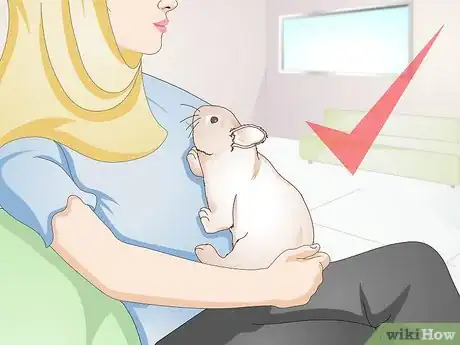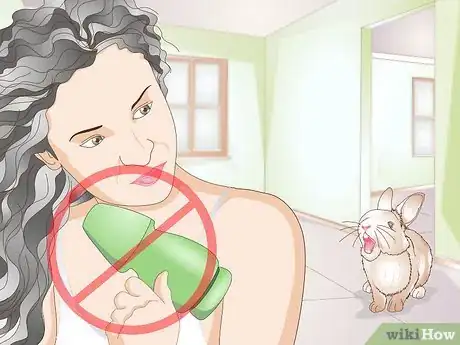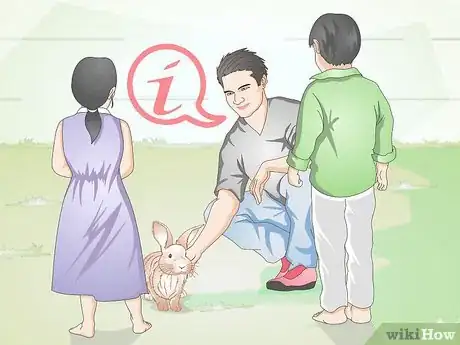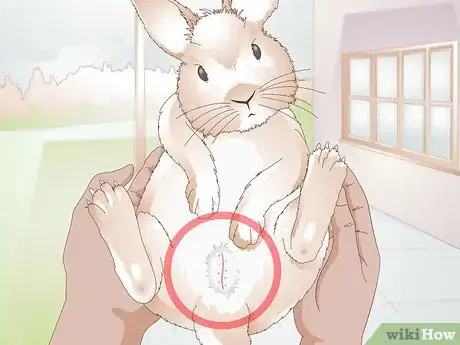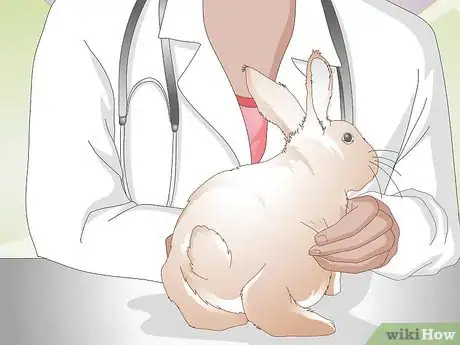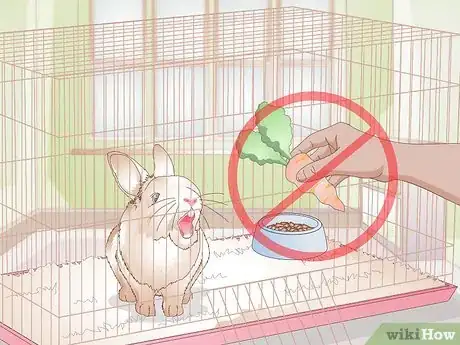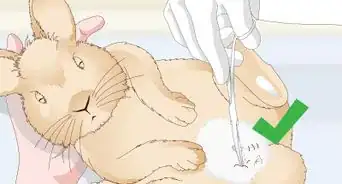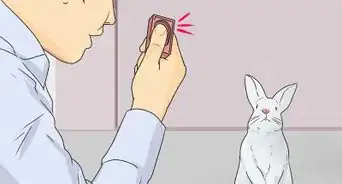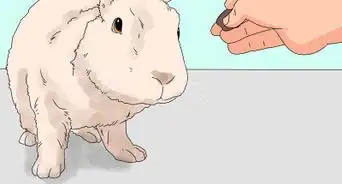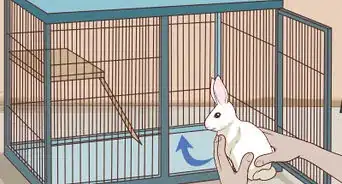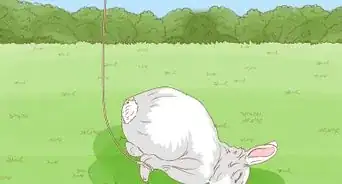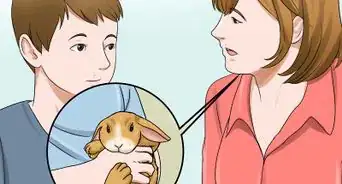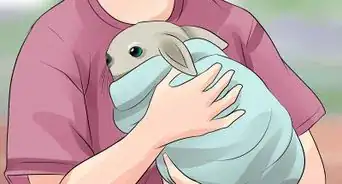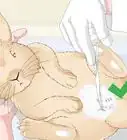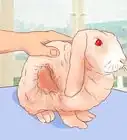This article was co-authored by Alisa Rassin. Alias Rassin is an Exotics Veterinarian and the Owner of The Exotic Animal Hospital of Pennsylvania in Lansdowne, Pennsylvania. With over a decade of experience, she specializes in treating reptiles, birds, and small mammals. She holds a Veterinariae Medicinae Doctoris from The University of Pennsylvania and a BS in Veterinary Biomedical and Clinical Sciences from Penn State University. She was also certified by the Royal College of Veterinary Surgeons.
wikiHow marks an article as reader-approved once it receives enough positive feedback. In this case, several readers have written to tell us that this article was helpful to them, earning it our reader-approved status.
This article has been viewed 85,920 times.
Does your rabbit bite or nip at your hands when you reach into its cage? Does it show its teeth or growl when you offer it your hand to sniff? Does it even chase you and lunge at you? Bunnies like these might seem like hopeless cases, but with a little care and precaution, there are ways to calm your fuzzy friend down.
Steps
Handling an Aggressive Rabbit
-
1Show the rabbit it’s hurting you if it bites. Make a sudden yelping sound or squeal when and if your rabbit bites or nips you. This will act as a kind of signal that you’re in pain, and your rabbit will associate that with biting you. [1]
- Tiny nips can just be your rabbit’s way of telling you to go away, or that you’re bugging it. They’re not trying to hurt you, just trying to let you know they don’t want to be touched or handled. Nips don’t usually hurt, and aren’t accompanied by aggression. Full bites are bad behavior that shouldn’t be encouraged or praised. These bites are painful, and the bunny might even latch onto you when he bites down.
-
2Hold your rabbit correctly. Incorrect handling could be painful for your rabbit. Your rabbit might act out in aggression if it is handled incorrectly. Make sure you support its back legs and avoid jerking your rabbit around at all. Be gentle, and support your rabbit’s spine.[2]
- Gently wrapping your rabbit in a towel is a safe way to restrain it if it is acting aggressively and you need to handle it, like to administer medication. You’ll, of course, want to make sure the rabbit can breathe well and that its nose isn’t covered.
Advertisement -
3Approach your rabbit carefully. If your rabbit bites or nips you when you reach out to it, it might simply be because you startled it. Rabbits can’t see very well up close; their distance vision is much stronger. So putting your hand right in front of your rabbit’s face can surprise it, which might make it feel as though it has to defend itself.[3]
- Pet your rabbit from above. Try not to put your hand down over its nose. Let him begin to associate hands reaching for him as something positive, as it results in getting affection.
- While you pet your rabbit, speak to it in a soothing voice. This will help him to relax and not be on the defensive.
Making Your Rabbit Feel Safe
-
1Be kind to your rabbit. Hitting your rabbit, yelling at it, or trying to force it to show you affection are all things you should never do. If you have a rabbit with aggressive or vicious tendencies, hitting the bunny will only make it more scared and stressed out. You want to earn its trust so that it will feel more comfortable around you.[4]
-
2Create a safe environment. Try putting your bunny and its cage into a small room, like the bathroom. Close the door, and then open the door to your bunny’s cage. Sit in the room with your rabbit, but let it decide when it wants to come out of its cage. Ignore your rabbit while you let it sniff you and hop around the room. Don’t pick your bunny up or even pet it. Try this a few times. Eventually, your rabbit will be used to you, and won’t see you as a threat.
-
3Take your time socializing your bunny. Rather than jumping right into holding or cuddling your bunny, take some time to let it warm up to you. This applies to any new people (or even other animals) that your bunny will encounter in its everyday life. If you let your bunny warm up to people at its own pace without forcing it, it will feel more relaxed and willing to interact.[5]
- Let your rabbit come to you rather than immediately picking them up.
- At first, you might try wearing gloves to protect your hands when handling your rabbit. Then, after some time and a few sessions of letting your rabbit get to know you and it hasn’t shown aggression or viciousness, you can take the gloves off.
-
4Try not to put your bunny in stressful situations. Keep an eye on your rabbit to see what things might be triggering its vicious response. It could be a certain noise, like the garbage disposal or the hair dryer, or it could be someone moving too quickly. Once you identify the things that seem to trigger the bad behavior, make sure to avoid those triggers.[6]
- Stress can lead to aggression in rabbits. Aggression is their way of defending or protecting themselves when they feel threatened. If you work to avoid putting your rabbit in the situations that make it feel stressed or threatened, its aggressive and vicious behaviors will likely lessen.
-
5Instruct children on how to interact with your rabbit. Children sometimes misunderstand the proper way to handle and interact with animals, and your rabbit might bite or nip a child that handles it incorrectly. Encourage children to touch your rabbit gently, speak softly, and avoid startling it.
Finding the Source of Aggression
-
1Have your rabbit neutered or spayed. One of the leading causes of aggression in rabbits is hormones. Rabbits that are not spayed or neutered are far more likely to become aggressive when they become mature, usually around 3-9 months of age. Getting your rabbit spayed or neutered could drastically improve its behavioral issues.[7]
- Some rabbit owners might think that breeding their female rabbit will have the same effect on her behavior as having her spayed. This isn’t true. Breeding your female rabbit isn’t an alternative to having her spayed. Any change that might appear in her behavior while she’s pregnant is only temporary, and those aggressive traits will reappear after she has given birth.
-
2Visit the vet. Aggression or viciousness might come about as a response to being in pain or being ill, so if your bunny shows this type of behavior—especially if it is sudden—make sure you get it to the vet to make sure it isn’t suffering from any kind of ailment or injury.[8]
- At the vet, make sure you ask about your bunny’s overall health. Ask about ways you might work to correct the bad behavior, and see if your vet has any suggestions or advice pertaining to your particular rabbit. If the vet says anything you aren’t clear about, ask questions, and get the information you need.
- You can do a quick check of your own at home before seeing a vet. Some signs of sickness might be runny eyes or nose, a spike in or lowering of body temperature (best felt through touching their ears), or even a loss of appetite. Any of these could be signs of a problem, so take your bunny to the vet if it displays any or some combination of them.
-
3Understand that rabbits are often territorial. Avoid trying to pull your rabbit out of his cage. Don’t take out its toys, food bowls, or anything else from its cage while it’s in it. Wait until it isn’t in its cage to clean it. If your rabbit bites you when you are reaching into its cage, it is likely being protective.[9]
- The best thing to do when reaching into your rabbit’s cage is to reach in just to pet it. Give your rabbit a little affectionate rub each time you reach in. Then, your rabbit will eventually learn that the hand reaching into the cage isn’t a threat, but rather something positive.
Community Q&A
-
QuestionMy rabbit won't even let me touch her without freaking out. How do I make her like me?
 Community AnswerYou will have to show her love and treats and confident strokes first. Don't try and pick her up until she is ready.
Community AnswerYou will have to show her love and treats and confident strokes first. Don't try and pick her up until she is ready. -
QuestionIf the rabbit doesn't like to coming out of it's cage, how will I keep it healthy?
 Warrant1987Community AnswerBeing housed in a cage is not healthy for rabbits. They need space to move and stand and jump. It is not uncommon for rabbits in cage to become "cage protective" where they get aggressive when people reach into their space. It is much healthier to house them in exercise pens with plenty of hay, chew toys, toss toys (like plastic keys for kids), then let them out for free roam time in a rabbit-proofed space each day.
Warrant1987Community AnswerBeing housed in a cage is not healthy for rabbits. They need space to move and stand and jump. It is not uncommon for rabbits in cage to become "cage protective" where they get aggressive when people reach into their space. It is much healthier to house them in exercise pens with plenty of hay, chew toys, toss toys (like plastic keys for kids), then let them out for free roam time in a rabbit-proofed space each day. -
QuestionHow can I tame my two bunnies? When I pick her up and she lays on my chest she always gets down and bites my arm. What do I do?
 Community AnswerSpend lots of time with her so that she gets used to you and knows you are not a threat. Otherwise, follow the steps in this article.
Community AnswerSpend lots of time with her so that she gets used to you and knows you are not a threat. Otherwise, follow the steps in this article.
Warnings
- Always handle a rabbit with care, even if he isn’t showing signs of viciousness.⧼thumbs_response⧽
Expert Interview
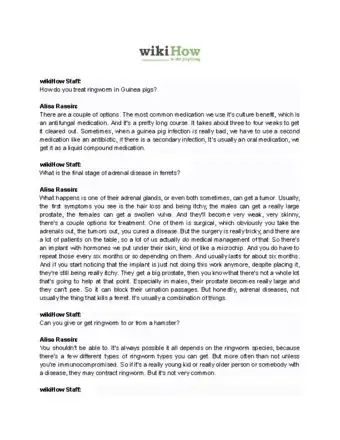
Thanks for reading our article! If you'd like to learn more about training rabbits, check out our in-depth interview with Alisa Rassin.
References
- ↑ http://rabbit.org/faq-aggression/
- ↑ http://web.jhu.edu/animalcare/procedures/restraint.html
- ↑ http://rabbit.org/faq-aggression/
- ↑ http://www.mybunny.org/info/problem-bunnies/
- ↑ http://animals.mom.me/calm-bunny-down-11149.html
- ↑ http://rabbit.org/faq-aggression/
- ↑ http://www.therabbithouse.com/behaviour/problem-aggressive-rabbit.asp
- ↑ http://www.therabbithouse.com/behaviour/problem-aggressive-rabbit.asp
- ↑ http://rabbit.org/faq-aggression/
About This Article
To calm a vicious rabbit, remember to approach it slowly and speak to it in a soothing tone of voice. Always pet your rabbit from above and try not to put your hand down over its nose. If you want to hold the rabbit, move slowly and be sure to support its back legs and spine. Try to avoid jerking your rabbit around as much as possible. Wrapping your bunny gently in a towel is a safe way to restrain it if it's being aggressive when you need to handle it. For tips on finding the source of your rabbit's aggression, read on!
